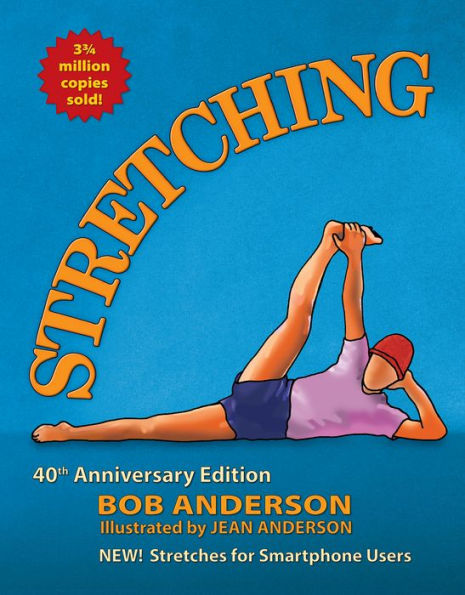The benefits of stretching are bountiful, from increased blood flow and better range of motion to improved physical performance and decreased risk of injury. Maximize your fitness journey with the most popular fitness book in the world! Stretching by Bob Anderson has been proven effective for decades. Now, with this 40th Anniversary Edition, a new generation can enjoy the advantages of stretching.
With step-by-step illustrations by Jean Anderson, Stretching is user-friendly. It’s the book that people tell their friends about, that trainers suggest for virtually every sport and activity, and that medical professionals recommend to people just starting to get back into shape. It features stretching routines specific to a variety of individuals, including sports enthusiasts, travelers, children, gardeners, and wheelchair users. A new section titled “Stretches for the Digital World” presents stretches for people using mobile phones and/or computers—to combat “tech neck”—as well as tips for better posture and stretches to do in an office environment.
This 40th Anniversary Edition contains:
- 150 stretches with simple instructions for each stretch
- 17 stretching routines for everyday activities
- 10 stretching routines for computer users and office workers
- 37 stretching routines for different sports
- Graphic index of all 150 stretches, useful for medical professionals and body workers in prescribing stretches for patients
- Tips on back care, body tools (e.g., personal massagers), and more
Stretching is a great addition on your path to better health. Get started with the guide that has been helping people around the world for more than 40 years.
The benefits of stretching are bountiful, from increased blood flow and better range of motion to improved physical performance and decreased risk of injury. Maximize your fitness journey with the most popular fitness book in the world! Stretching by Bob Anderson has been proven effective for decades. Now, with this 40th Anniversary Edition, a new generation can enjoy the advantages of stretching.
With step-by-step illustrations by Jean Anderson, Stretching is user-friendly. It’s the book that people tell their friends about, that trainers suggest for virtually every sport and activity, and that medical professionals recommend to people just starting to get back into shape. It features stretching routines specific to a variety of individuals, including sports enthusiasts, travelers, children, gardeners, and wheelchair users. A new section titled “Stretches for the Digital World” presents stretches for people using mobile phones and/or computers—to combat “tech neck”—as well as tips for better posture and stretches to do in an office environment.
This 40th Anniversary Edition contains:
- 150 stretches with simple instructions for each stretch
- 17 stretching routines for everyday activities
- 10 stretching routines for computer users and office workers
- 37 stretching routines for different sports
- Graphic index of all 150 stretches, useful for medical professionals and body workers in prescribing stretches for patients
- Tips on back care, body tools (e.g., personal massagers), and more
Stretching is a great addition on your path to better health. Get started with the guide that has been helping people around the world for more than 40 years.

Stretching: 40th Anniversary Edition
240
Stretching: 40th Anniversary Edition
240Paperback(Anniversar)

Product Details
| ISBN-13: | 9780936070841 |
|---|---|
| Publisher: | Adventure Publications, Incorporated |
| Publication date: | 10/06/2020 |
| Edition description: | Anniversar |
| Pages: | 240 |
| Product dimensions: | 8.50(w) x 10.80(h) x 0.70(d) |
